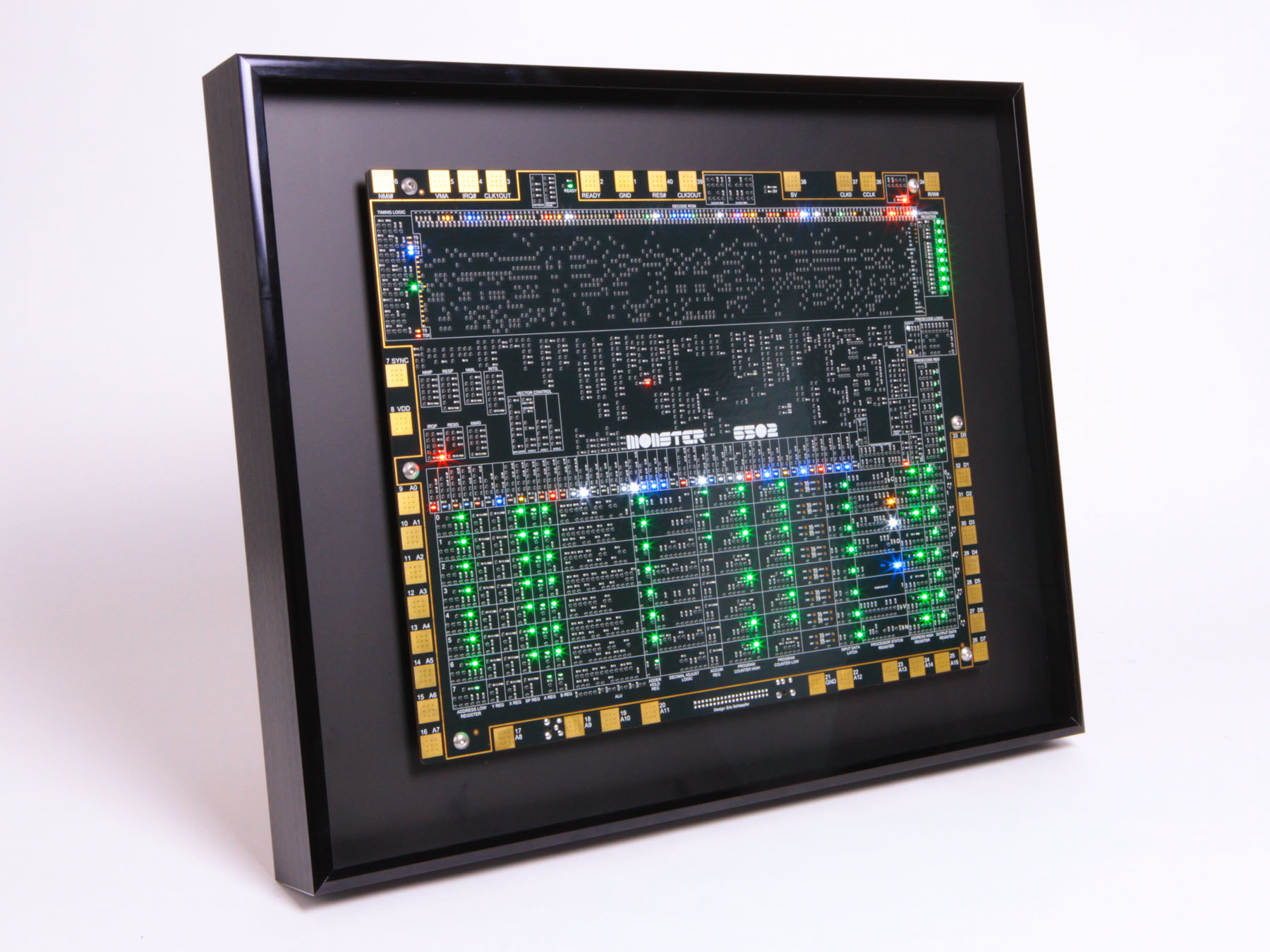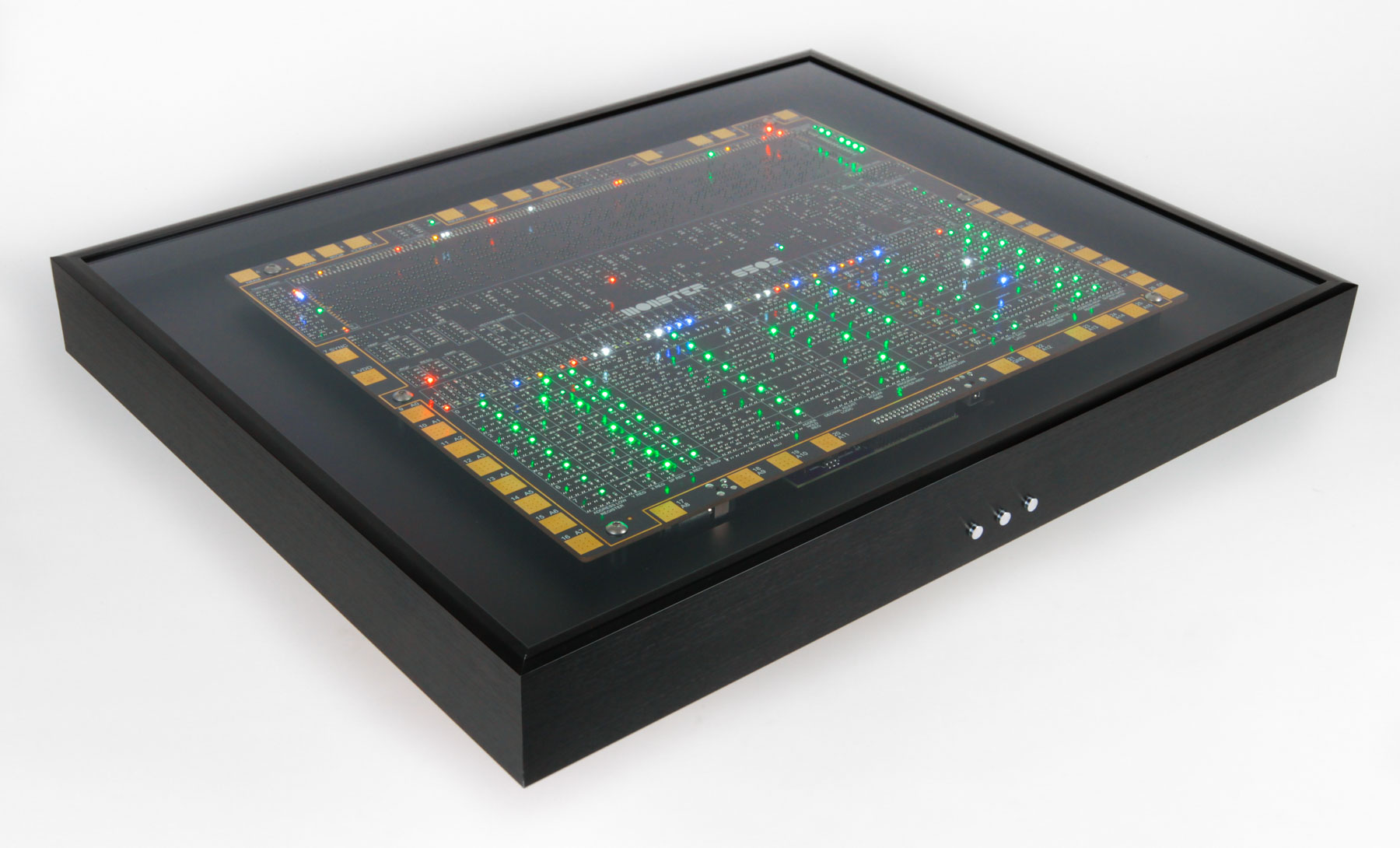
The MOnSter 6502
A
dis-integrated circuit project to make a complete, working transistor-scale replica of the classic
MOS 6502 microprocessor.
Video
FAQ
Sixty-Five-Oh-What?
The 6502 is the famous processor found at the core of such influential computer systems as the Apple ][, the Commodore PET, the Atari 400 and 800 home video game consoles, the BBC Micro, and the Tamagotchi digital pet. Slight variations of it were found in the Commodore 64, the Atari 2600, and the original Nintendo Entertainment System.

What's with the name and capitalization?
MOnSter 6502 is a play on the original manufacturer and device name (MOS 6502) as well as acknowledging its large size.
How big is it?
It's a four layer circuit board, 12 × 15 inches, 0.1 inches thick, with surface mount components on both sides.
How many components are there on the board?
In total, there are 4769 components on the board. There are 3218 transistors and 1019 resistors that comprise the "functional" part of the 6502.
In addition to these, there are also LEDs sprinkled throughout that indicate the values of various control lines, registers, and status bits, as well as additional transistors and resistors (not counted in those "functional" totals) that are necessary to drive those LEDs.
As of the second revision of the board, the design statistics are as follows:
- Components that correspond 1:1 with transistors in the original 6502:
- Total active transistors: 4237
- 3218 enhancement mode n-channel MOSFETs
- 2588 discrete
- 630 located on 164 quad transistor array chips (26 of these 656 transistors are not used)
- 1019 resistors (the original 6502 used depletion mode MOSFETs in place of resistors)
- 998 Additional parts present only in the MOnSter 6502:
- 313 LEDs (The first revision board, shown in the video, has only 167 LEDs)
- 270 extra MOSFETs for driving the LEDs
- 20 filter capacitors
- 32 bus capacitors
- 2 zero-ohm jumpers for net tie reasons
- 8 current limit resistors
- 314 resistors for the LEDs
- 36 diodes for ESD protection
- 2 jacks for 5 V power: main and alternate location
- 1 rectangular connector for the 40-pin "ICR" ribbon cable
- Total parts: 4769
Are you nuts?
Probably.

What is the current status of the project?
Headed towards a full public launch; delayed a bit by COVID.
The first full-scale prototype was publicly demonstrated at the
2016 Bay Area Maker Faire. We brought it up to the stages of successfully running various programs in assembly,
BASIC, and
Forth. Our second prototype, a year later, fixed a few issues that we encountered when bringing up the first version (removing all of the patch wires) but also added over 100 additional LEDs, including one for every instruction decode line on the 6502's decode ROM.
Since the 6502 is just a microprocessor (CPU), about half of our work on the project (and most of our work since the first prototype) has actually been building up the capabilities around this processor — adding interfaces for a keyboard,
monitor, and programming — so that you can actually use it. In the process of doing so, we have built up a single-board computer (a tiny motherboard) that uses the 6502 as its CPU, such that you can either use a socketed (vintage) 6502 IC, or the MOnSter 6502 through a cable.
More, we have been working towards a public launch, currently planned for mid-2023, building the MOnSter into
a shadowbox
enclosure complete with a tiny hidden "motherboard" that the CPU sits in, so that it can run demonstration programs even without being plugged into a separate computer.
Does it run at the full speed of an original 6502 chip?
No; it's relatively slow. The MOnSter 6502 runs at about 1/20th the speed of the original, thanks to the much larger capacitance of the design. The maximum reliable clock rate is around 50 kHz. The primary limit to the clock speed is the gate capacitance of the MOSFETs that we are using, which is much larger than the capacitance of the MOSFETs on an original 6502 die.
Can you hook it up inside an Apple ][ and run Oregon Trail?
No, not directly. It's neat to think of plugging the MOnSter 6502's
in-circuit emulator (ICE) in-circuit replica (ICR) cable directly into a socket inside an Apple ][, but that wouldn't actually work. The Apple ][ design relies on a number of clever tricks that derive timing for video generation and peripheral control from the main clock signal — all of which will fail if you need to run at a slower speed.
There are some ways to get around limitations like these. For example, the
Replica I computer (an Apple I clone) uses a Parallax Propeller chip to emulate a system clock and some of the timing-dependent external processing. The
RetroShield 6502 is another example of a software-implemented Apple I compatible that can use a hardware 6502 processor. We are most excited about the new
SmartyKit Apple I replica, which is specifically designed to run at a slower clock speed. You should also be able to put a slower clock into
Ben Eater's 6502 computer in order to "plug in" the MOnSter.
So what can it do?
It can act as an in-circuit hardware emulator for a 6502 integrated circuit, in any circuit that can run at a relatively low clock rate. We're currently running it on a custom 6502 development board (the single-board computer that we mentioned earlier) and doing things like running running BASIC, much as you would on an Apple ][. We have also plugged it into the CPU sockets of a few people's homebrew 6502 computers (including the
Cactus and
RetroShield 6502) that could run at variable clock speed. We are interested in finding other applications where it could be substituted for an original 6502.
How long did it take?
This has been a ~8 year project, thus far. The primary design work was done over six months, from
July 3 to
December 1, 2015. There have been several stages of reviews and revisions since then, and a few generations of the "motherboards" that we have run the MOnSter in.
Is it truly a "discrete 6502?"
Not in the strictest sense. However, it really depends upon how picky you would like to be.
The MOnSter 6502 uses the original dynamic
NMOS logic design, implemented at the individual transistor level.
Dynamic NMOS requires a large number of "transmission gate" transistors that are used to switch currents. For various technical reasons, only a 4-terminal MOSFET can make an effective NMOS transmission gate. Unfortunately, individually packaged 4-terminal MOSFETs are no longer commercially available. However, they do still make arrays of 2 or 4 MOSFETs on a single chip with a separate substrate pin. We used the 4-pack version — These are the quad transistor array chips that we mentioned earlier.
Because these transistors do share a pin, there are (strictly speaking) integrated circuits in the MOnSter 6502. However, one might credibly argue that it is a discrete transistor design since there are not (for example) any logic gate chips in the circuit.
What are those little gold squares around the border?
The 40 square pads around the edge of the circuit board correspond to the 40 pins of the original 6502 integrated circuit. They're also designed to look like the wire-bond contact pads on an IC die — where the IC would be physically connected inside (for example) a 40-pin DIP package. These pads are functional contact points on the MOnSter 6502; you can hook up to them with alligator clips to probe or communicate with any pin.
How much power does it draw?
It draws up to roughly 2 A at 5 V, or 10 W total. The LEDs are a significant part of the power consumption.

Can I see it in person?
Due to the ongoing pandemic we haven't been taking the MOnSter to shows lately, but you can come visit us
by appointment at Evil Mad Scientist Laboratories in Sunnyvale California for a demonstration. Please
use our contact form to ask about available demonstration times.
How big is the MOnSter 6502 compared to the original 6502 die?
The original device was
153 × 168 mils (3.9 × 4.3 mm) or an area of 16.6 square mm. Given that ours is 12 × 15 inches, that makes it about 7000 times actual size.
How big would the MOnSter 6502 be if it were made with through-hole parts instead of surface mount parts?
About 19 square feet (1.7 square meters).
How big would a 68000 microprocessor be at the scale of the MOnSter 6502?
Also about 19 square feet (1.7 square meters).
Are you going to make a 68000 next?
No.
How big would a modern CPU be at this scale?
The
Apple A8X, found in the iPad Air 2, contains about 3 billion transistors. (This is comparable to the number of transistors in modern desktop computer CPUs as well.) At the scale of the MOnSter 6502, that would take about 885,000 square feet (over 20 acres or 8 hectares) — an area about 940 ft (286 m) square.
Are you going to make a dis-integrated modern CPU next?
No.
Are you going to make one out of vacuum tubes next?
No.
Are you going to make one out of relays next?
No. (Aren't we already doing enough to fight Moore's law?)
Can I buy one?
Hopefully in the near future! We are working towards a public launch, currently planned for Mid 2023; please
Sign up for our mailing list if you would like to receive updates as we get further along.
Is it expensive?
It is definitely not cheap to make one of these. We are currently estimating the cost at between $2k - $4k.
While the circuit board itself is large and a little bit expensive, the cost is actually dominated by the
component and assembly costs of an extremely large number of tiny components, most of which are individually
not that expensive. Add to that the setup and test costs of building complex things like these in small batches,
and you can immediately see how it adds up.
Is there going to be a soldering kit version of this?
No. (But on the other hand, "Anything is a soldering kit if you're brave enough!")
Credits
The MOnSter 6502 is a continuing work in progress, designed by
Eric Schlaepfer, in collaboration with
Evil Mad Scientist Laboratories. Together, we're the folks that brought you the "
Three Fives" discrete 555 timer, the
XL741 discrete 741 op-amp, and the book
Open Circuits.
Special thanks to
Ken Shirriff,
visual6502.org, Chuck Peddle, and
Bunnie Huang.
Stay up to date!
Please
join our mailing list for occasional future updates.



